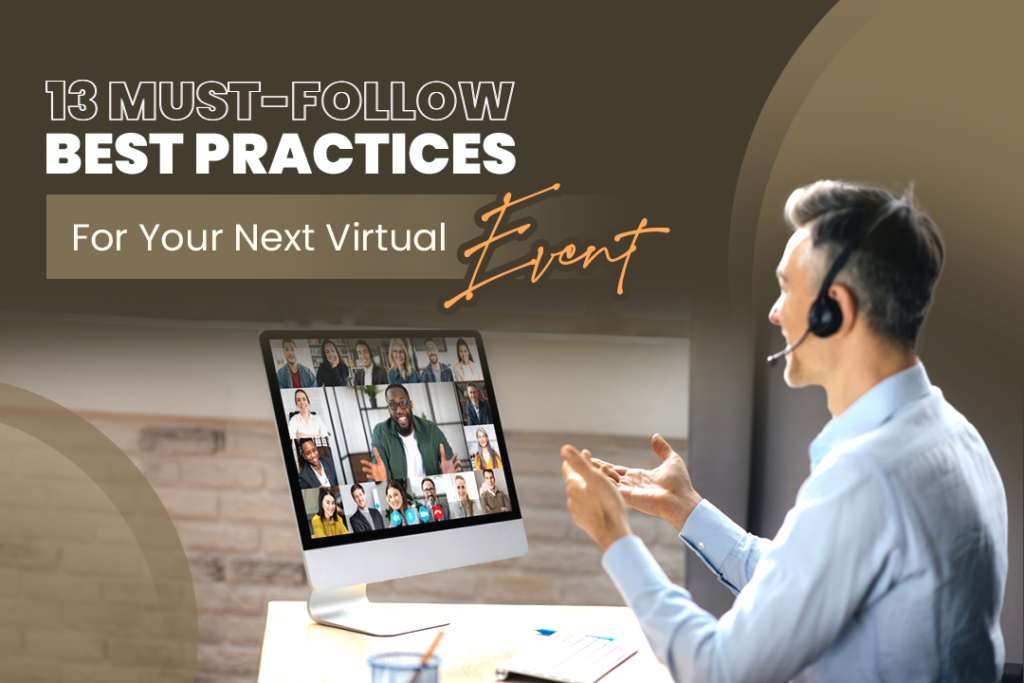
The journey to making impactful connections has transcended time and space. Organizing events for people across the globe is no longer a challenge. The pandemic served as a potent opportunity for event planners and attendees to explore a new way of accomplishing business goals through virtual and hybrid events.
What started as a substitute for in-person events is slowly becoming the norm. Many businesses now prefer to organize virtual or hybrid events to connect with their employees worldwide. Event organizers have become adept at planning virtual trade shows, conferences, webinars, workshops, and much more. The reasons for this range from cost and time effectiveness to the ability to seamlessly maneuver logistical challenges.
There are several things to consider when organizing a successful virtual event. Here we have compiled 13 virtual event best practices that every event marketer should consider following to take their virtual event to the next level.
13 Virtual Event Best Practices to Watch Out For in 2024
Here is a list of 13 best practices for virtual events to keep an eye out for this year
1. Understanding the Target Audience
Just like any other in-person event, an event organizer needs to understand the target audience. They should create personas of possible event attendees based on the type of virtual event and the business goal associated with it. For example, suppose the event is about a virtual conference promoting new-found drugs in heart disease. In that case, the organizer should target medical professionals, pharmacists, and other stakeholders who would benefit from acquiring knowledge in this area.

Identifying the target audience should be the starting point before diving deep into event strategy and planning. Once that is done, you can choose the ideal virtual event platform, define content strategy, create promotional channels, budget, etc.
2. Choosing the Right Virtual Platform for the Event
Gone are the days when Zoom was the only option for a virtual conference. Now, event organizers opt for sophisticated virtual event platforms that successfully hold the attention of the attendees and give them a realistic event experience online.
A virtual event platform with smart technology that combines interesting audiovisual elements and interactive features is the key to increasing an online event’s experiential value and maximizing participation and engagement.

Some of the main features of a good virtual event platform are breakout spaces for networking, gamification, live streaming, polling, Q&A meet-ups, virtual group discussions, and post-event feedback. Depending on the business goal and the type of virtual event, you can choose from a wide range of platforms, such as vFairs, Hoppier, Weve, and Microsoft Mesh.
3. Defining a Content Strategy
Content strategy is crucial to the success or failure of a virtual event. When everything is digital, the nature of your content will decide attendees’ participation level. Ensuring a coherent content strategy is one of the most critical best practices for virtual events.

Curating keynote speakers and workshops to cater to the needs of the attendees will go a long way to ensure the event’s overall participation and engagement level. Ideally, there must be a mix of live and pre-recorded content during these large-scale events.
Many virtual event hosting platforms offer features that allow attendees to participate in simulated live sessions, which enhances the overall experiential quality of the virtual event.
4. Gamifying Event Content
Who doesn’t love the thrill of getting ahead on a gaming scoreboard? You can capitalize on the same concept for your next virtual event by introducing fun games like trivia, virtual scavenger hunt, bingo, and contests in between sessions.
Make sure to have a leaderboard displaying the scores of the top performers and incentivize the game with exciting prizes for winners. Gaming adds to the visual element of your virtual event and allows attendees to break free from the monotony of attending sessions for long hours.
5. Creating an Interactive Setting
Nobody wants to simply stare at their screens while attending a virtual event. After a point, they will experience screen fatigue and lose interest in the event.

This can be prevented by incorporating various interactive elements in between sessions. For example, the audience can vote live, conduct spot quizzes, and announce winners during the event, making the overall experience as immersive as possible with the effective use of virtual reality and augmented reality tools.
6. Choosing Innovative Networking Opportunities
In a virtual event, thinking out of the box is crucial to creating ample networking opportunities within the digital space. To do this, organizers can use innovative virtual event platforms that provide attendees with one-on-one and group discussion features. They can also use spatial connections to create virtual spaces like cafes and parks where attendees can move around and converse with others.
The event platform can also use the data of attendees to match like-minded individuals and provide them with suggestions for other attendees to connect and discuss relevant topics. Other ways to increase networking opportunities include timely Q and A sessions and encouraging the participants to communicate with their peers from time to time. For instance, to know more about the importance of including a Q and session in your event schedule, read our article, “15 Tips That Guarantee A Productive Q&A Session.”
7. Crossing the Language Barrier
To create successful online events, connecting with the audience across cultures and time zones is imperative. With live translation software, businesses can appeal to a massive audience. It facilitates increased localization for countries that are not English-speaking. Many developed countries like France, Netherlands, Norway, and Sweden have their native languages.
With live translation, businesses will attract more attendees and establish themselves as reliable brands in the world of digital events.
8. Incorporating Breaks in Between Sessions
Expecting attendees to be continuously glued to their screens to attend the event is impossible. Even during in-person B2B events, guests usually take breaks from time to time. So, while planning the agenda for the event, allot sufficient time for breaks between sessions.

Pic Courtesy: Freepik
You can start with the basics by including lunch, hi-tea, and other small breaks after each keynote speaker’s session. This will give the attendees the necessary time to grab a bite and refresh themselves before returning to attend the other sessions.
9. Using a Mobile Event App
One way to maximize participation for your next virtual event is to make all event-related information accessible to attendees. The best way to do this is to have an event app that contains the agenda, gamification rules, speaker’s list, networking opportunities, follow-up, and everything else related to the event.

This app can also be a great tool for organizers, who can track the total number of attendees and other guests who will participate in the event. If you wish to know more about these event apps and find out some of the best in the B2B space, check out our article, “7 Best Conference Apps: The Must-Have Tools for Event Attendees.”
10. Promoting the Event for Maximum Reach
11. Doing a Post-Event Analysis
After the event, connect with all attendees to get their feedback. This will help improve future events. It also allows you to network and foster relationships with the attendees while making them feel valuable through their contribution.
You can use KPIs like engagement, lead generation, attendance, the usability of the content delivered during the event, session recordings, sponsorship ROI, and technical feasibility. A detailed event analysis will help the event organizing team understand the gaps in their overall functioning and work on them for the next event.
Take a look at the post-event analysis done by our team at Eventible for the Ai4 Conference 2022. While this event was not entirely a virtual event, a post-event analysis report like this can be created for all virtual events to give a comprehensive account of the event’s overall performance.
In the report, the event is reviewed based on the overall attendee participation and reception and the sponsor’s sentiment towards it. Emphasis is placed on what went well and what needs to be improved. This comprehensive analysis acts like a mirror to all the effort poured into the event. It then helps virtual event organizers elevate their event planning strategy.
12. Sending Sponsorship Packages
To attract sponsors for your virtual event, consider sending sponsorship packages that include information about your organization, the event’s purpose, the agenda, the benefits of becoming a sponsor, potential engagement opportunities, and your contact details.
Large-scale events usually attract many sponsors, and sending these packages can be a good starting point for getting them on board.
13. Offering Recorded Sessions After the Event
Your event content is extremely valuable; after all, you went through the trouble of curating it. It only makes sense to make the most of it by repurposing it. You can use clips of your recorded sessions for your social media pages, create a post-event showreel, or offer the entire recording to your attendees, who can keep going back to it as they please.
Key Takeaway
Although virtual events have become an integral part of the events industry, it is still a relatively new way of getting people to collaborate and connect to achieve business goals. Unlike in-person events, ensuring engagement and interaction among attendees can be challenging. Moreover, the tendency to experience screen fatigue can hamper the success of any virtual event.
However, by following these 13 virtual event best practices, you can give your attendees an immersive and wholesome experience. With the help of sophisticated event technologies, you can take your event to a whole new level. Here is a guide to the event technologies that can create an impact for your next event.




Comments are closed.